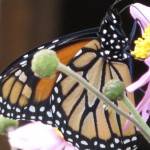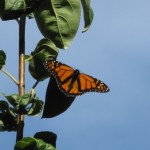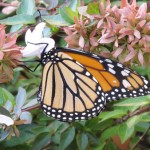 |
 |
 |
The monarch is the most widely known and readily recognizable butterfly in the eastern United States. Between August and November each year, virtually the entire North American population of the species migrates to winter roosts in fir forests in the mountains of Mexico. Above, from left to right: Ventral view of an adult monarch feeding on a Japanese anemone in Cuxa garden; dorsal view of a male monarch hovering near a crabapple shoot; ventral view of a monarch feeding on a tubular flower of Abelia x grandiflora. Photographs by Corey Eilhardt.
The annual northern and southern migrations (see image) of the monarch (Danaus plexippus), the most beloved and familiar of North American butterflies, are monitored not only by professional lepidopterists, but also by many citizens and students across the country. In late summer and autumn, monarchs in the millions make for their ancestral wintering roosts in forests of oyamel fir trees (Abies religiosa) which grow??at heights of ten thousand feet in the Sierra Nevada mountains of Mexico. (This range is also known as the Trans-Mexican Volcanic Belt.) In spring, the monarchs return to the United States and Canada. For more information about migration, habitat preservation, and the life cycle of the monarch, visit the inter-agency website maintained by the U.S. D. A. Forest Service.
The insects’ movements en route are tracked and recorded, and individual butterflies are tagged. By documenting an initial point of capture and coordinating it with the point of recapture, researchers can determine information about the routes taken by the butterflies, as well as other aspects of their migratory behavior. For bibliographies of both scientific and popular literature on the monarch, visit the reading room on the MonarchWatch website.
Although the monarch belongs to the Nymphalidae family of Lepidoptera, and the swallowtail belongs to the Papilionidae, the two species have something in common: the bodies of both contain cardiac glycosides that are toxic to predators. For information on the black swallowtail butterfly, an earlier visitant to our gardens than the monarch, as well as cardiac glycosides, see “Fed On Fennel,” (September 15, 2010).
For a comprehensive guide to the identification of butterfly species in North America and throughout the world, visit the website of The Lepidopterists’ Society.
???Deirdre Larkin
Source:
Cech, Rick and Guy Tudor. Butterflies of the East Coast: An Observer???s Guide. Princeton: Princeton University Press, 2005.
Tags: Abelia grandiflora, Abies religiosa, butterfly, crabapple, Danaus plexippus, Lepidoptera, lepidopterist, Mexico, migration, monarch, Nymphalidae, Papilionidae, Sierra Nevada

October 12, 2010 at 11:32 am
Great post! Glad to see you have a nice pollinator population.
December 29, 2010 at 10:28 am
Dear Kristen,
We are really pleased with the number of bees and butterflies we host in these gardens, and intend to do all we can to continue to attract and maintain them. Fascinating as plants are, my as yet very tentative investigations into entomology have been mind-blowing. The subtlety of adaptation and the complexity of organization in the insect world is awesome.
D.